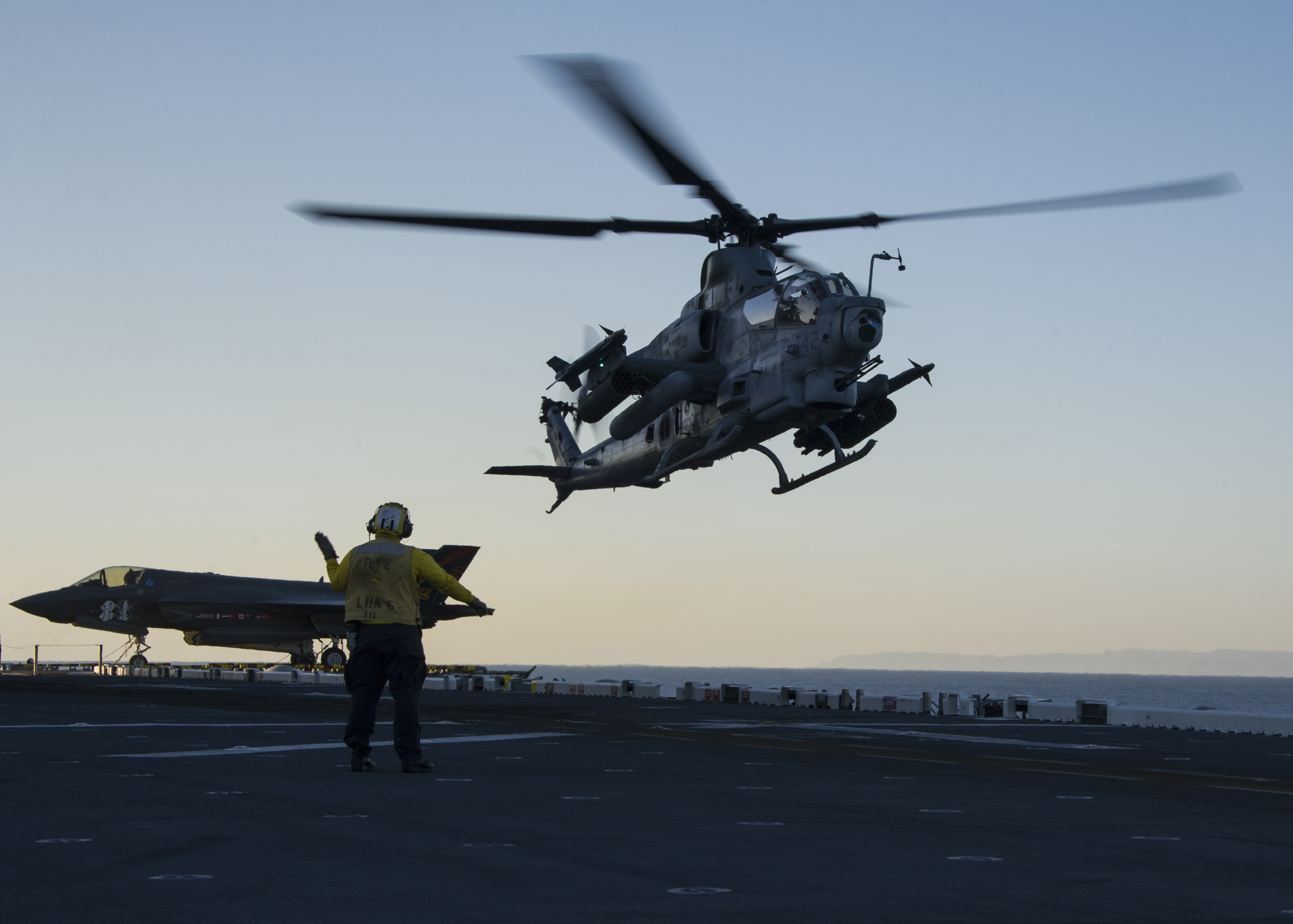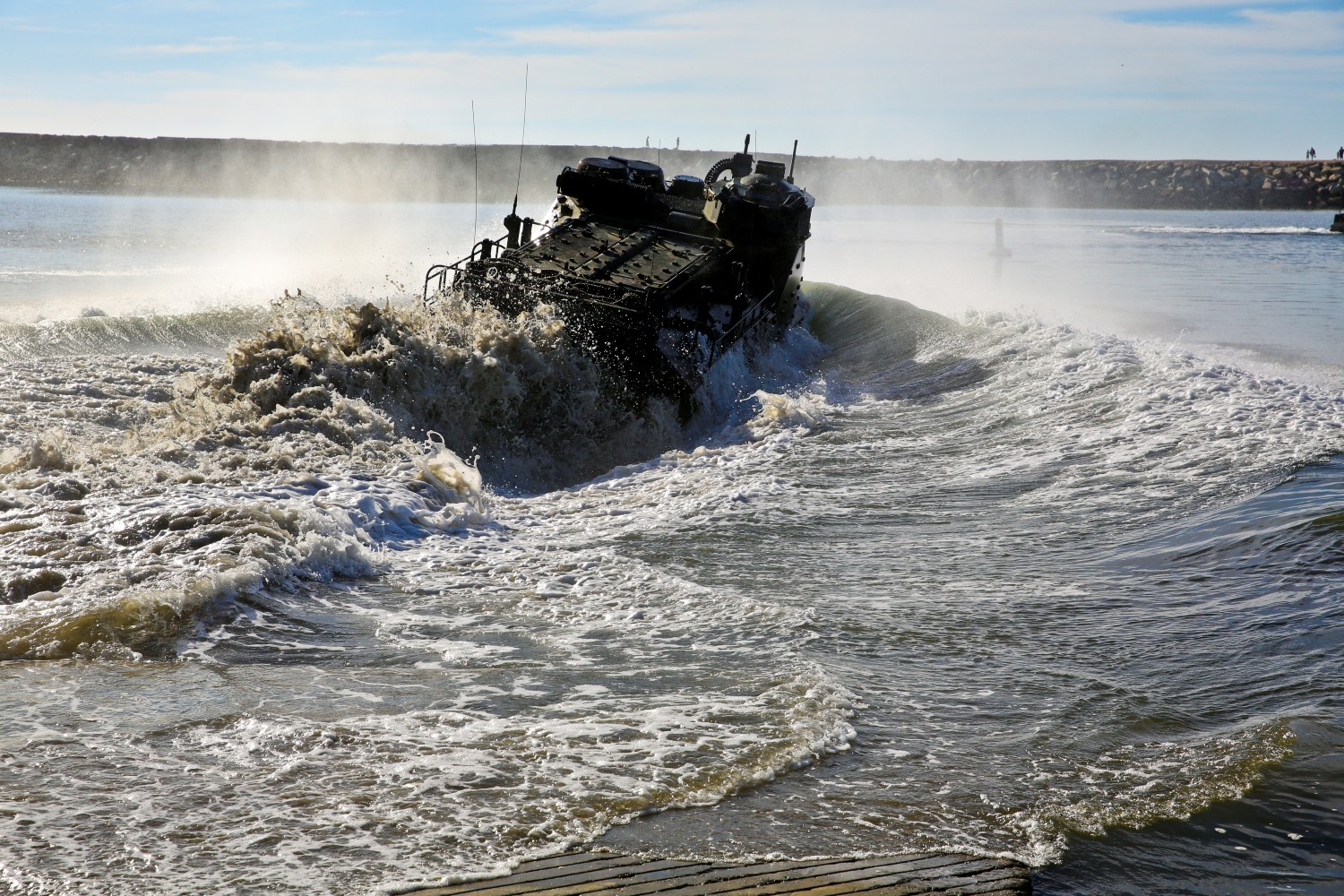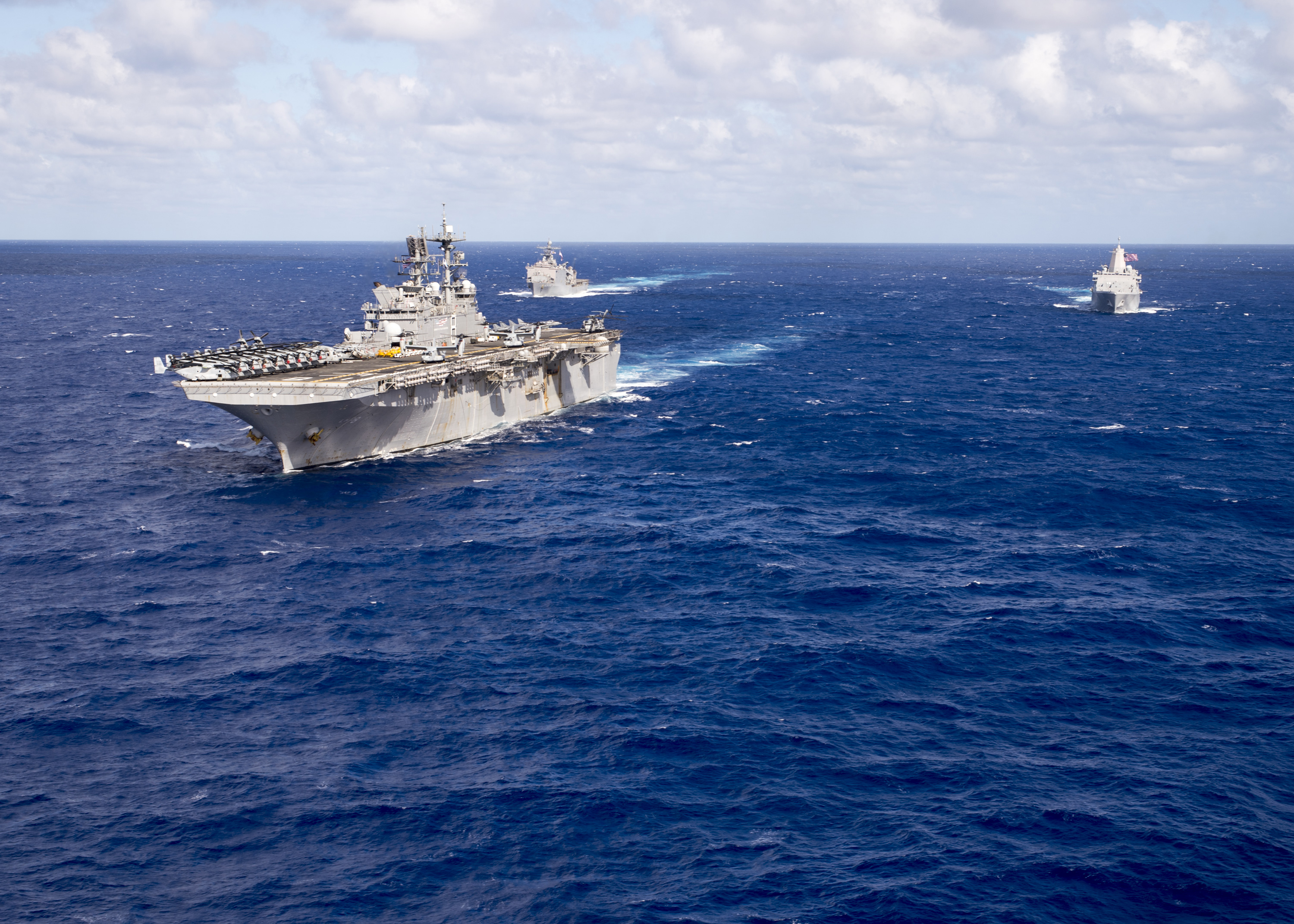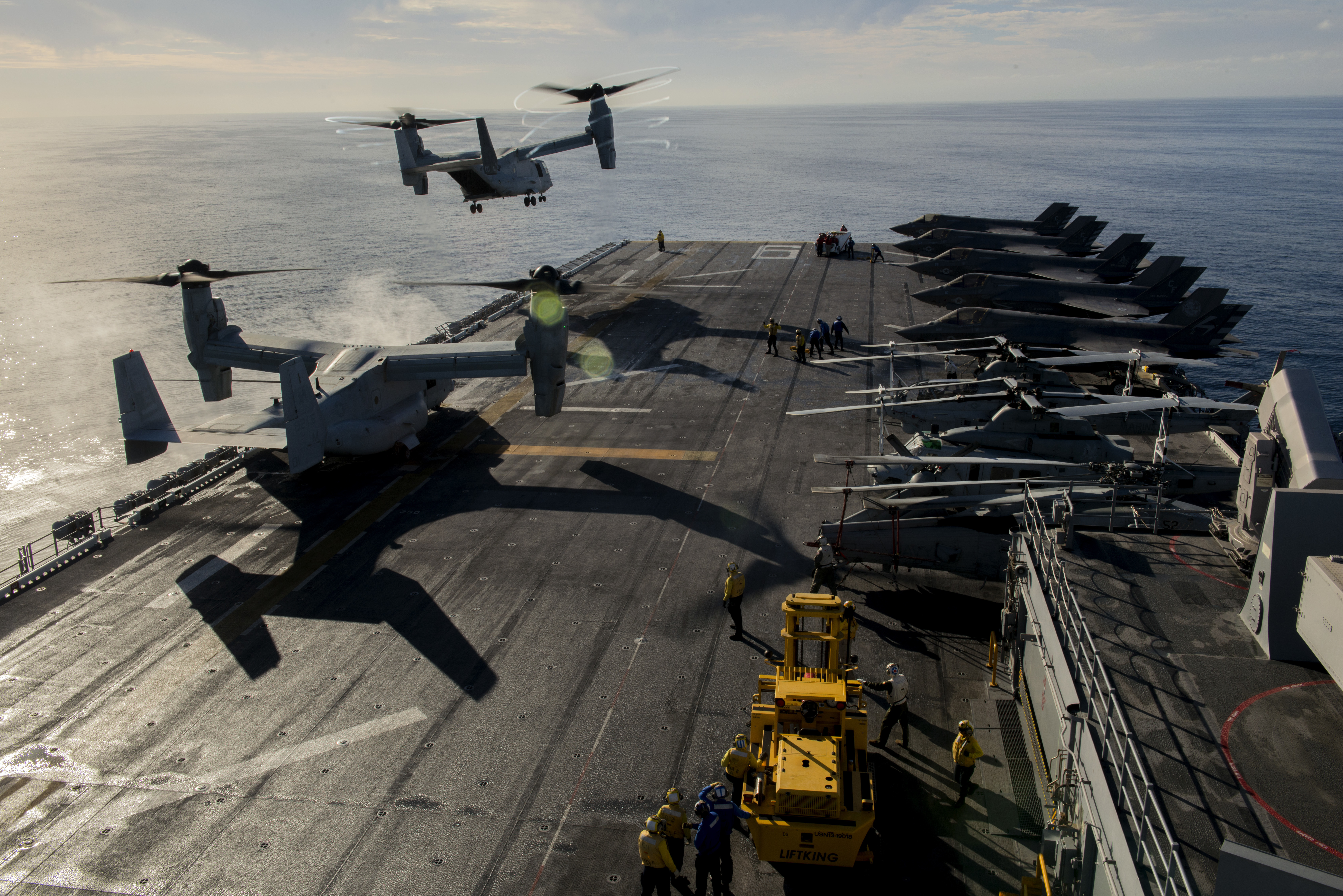
A future naval campaign against an enemy armed with long-range precision weapons will require the Navy and Marine Corps to disaggregate, creating temporal sea and air control with small units that can move from the sea to the shore and back again to meet an objective and then move on to the next task.
This type of maneuver warfare – which relies on expeditionary advance base operations – is supported by some new weapons and platforms coming into the fleet, but other innovations will still be required for the sea services to be successful in this type of operating environment, officials have said.
Director of Expeditionary Warfare Maj. Gen. Christopher Owens (OPNAV N95), while giving a talk with his surface warfare counterpart earlier this month, said Marine Corps aviation advances will help the green forces contribute more to sea and air control.
“We often talk, especially in the aviation world, about BISOG — Blue in support of Green. In amphibious operations what that usually means is the Navy getting the Marines in position to land a landing force,” Owens said during his talk at the Surface Navy Association annual symposium.
“However, our ability to integrate into a truly naval force is growing, and it’s going to continue to do so into the future. And it’s time we start talking more about Green in support of Blue. So what do I mean by that? … Beginning in 2018 we will deploy F-35Bs from our big-deck amphibs. And this isn’t just about using stealth to drop bombs or take on enemy fighters; the F-35B is a flying broad area sensor and a sensor-fusion system, and it’s going to open up possibilities the naval force has not had before. And we’re going to have those aircraft out aboard our amphibs several years before we have them aboard the carriers. Second, the range, speed and capability of our MV-22s will open up huge areas of the sea previously out of reach to seaborne forces, and this is going to allow our ships to maintain greater standoff while increasing the speed and unpredictability of our maneuver. They can help us find or create seams and gaps, too many perhaps for an enemy to encounter. And the more sea space we can cover, the more options we generate and the more we complicate and enemy’s problem-solving. Finally, our Marines and Navy expeditionary forces can go ashore to remove a threat, provide fires in support of sea control, conduct surveillance and reconnaissance, or establish advance bases, rearm-refuel points for aircraft or logistics staging areas. We can deceive the enemy, we can seize or hold at-risk something he values, force him to react to us and draw him into our engagement range.”
Commandant of the Marine Corps Gen. Robert Neller told USNI News at the same symposium that the Marine Corps has long been set up for these kinds of operations, but the service is looking into reinvigorating this type of operation through new training and weapons.

“Whether it’s establishing a forward arming and refueling point, … whether it’s to secure a piece of key terrain to deny access to a sea line of communication or a geographical chokepoint, I think this idea is not a new one, but it’s not one that we’ve had the discussion about here in the recent past,” he said.
“So in our exercises and in our training and in our discussions with our shipmates, I’m pretty confident that the Marine commanders and the Navy commanders are having this discussion. Now there’s some capabilities that would be beneficial for that – surface-launched precision fires and things like that probably would need to be expanded a little bit, but I’m not going to say any more about that because there’s a lot of work going on about that, we’ll see how it all plays out. But as far as understanding what the mission is, that’s what we do.”
Expeditionary Advance Base Operations

Expeditionary advance base operations is not a new idea but was emphasized anew last year in response to global operating conditions. “Gaining and maintaining sea control in close seas” has been where the Navy and Marine Corps have had the hardest challenges, and EABO does several things to get at that problem set, explained Art Corbett, head of the Naval and Marine Corps Concepts section in the Marine Corps Combat Development Command MCCDC)’s Futures Directorate.
First, Corbett said, in the face of long-range precision weapons, EABO seeks to “gain the virtues of mass without the vulnerability of concentration,” so “we disperse our capabilities in such a way that they defy easy targeting, and we make it so that the level of effort and the cost imposition on the adversary is greatly enhanced.”
Next, he said, is “winning the hider-finder competition.” On the hiding side, the Navy and Marines would want to bring certain capabilities like anti-ship cruise missiles ashore, where they can be more easily concealed on land than they could at sea. The disaggregated units would also need to conceal their electromagnetic spectrum signature. On the finding side, Corbett said the naval forces will have to boost their scouting forces – manned or unmanned – to get better situational awareness. The U.S. has long-range weapons too, but with that range comes an even greater strain on intelligence, surveillance and reconnaissance (ISR) assets to find targets for those weapons – called the R-squared problem, for the area that the weapon’s range creates.
Cornett said U.S. military strategy compels forces to be forward in support of treaty allies, which plays nicely into EABO as well. Some allies, such as the Philippines, are in vulnerable close sea locations, and Marine forces operating from the allies’ land simplifies the hider-finder problem for the U.S., giving a safe land location to hide and launch scouting missions.
“If I have to have a (ISR) system that’s trans-oceanic, then it’s going to be fairly big, have a large signature, and it’s going to be expensive, probably rather sophisticated,” Corbett said of trying to launch scouts from the United States, ships at a great standoff distance or other more distant allies’ shores.
“But if I can take advantage of a friendly partner who has close proximity to the area of interest, then I can proliferate many smaller platforms that will be inherently harder to find, have lower signature, I can have more of them and I can solve the R-squared problem.”
Owens also discussed the importance of treaty allies in EABO, saying “forward-deployed expeditionary forces (such as those stationed in Japan and South Korea) create and maintain the access that we’re going to need. They build interoperability with our allies and partners and allow us to spend time in areas close to where we might be needed, whether it’s for natural disaster, to rescue Americans in danger or to respond to aggression.”

All told, EABO paints an interesting picture of what a possible conflict in a place like the South China Sea could look like. Rather than send high-value assets like an aircraft carrier or amphibious assault ship into a crowded and vulnerable location, long-range aircraft like the MV-22 Osprey would allow Marines to take up ground positions in a friendly nation like the Philippines, where they’d bring with them anti-ship and anti-air weapons and move around as needed to hit targets and to stay hidden from the enemy. These land-based units, then, help create a safer situation for high-value assets – not just carriers and amphibs, but also logistics ships – to come in when needed and then depart again.
Though some platforms like the V-22 and F-35B are already being fielded, and the Marine Corps has ongoing efforts in the areas of weapons and ship-to-shore maneuver facilitators that would boost this type of warfare, Corbett said innovation in other areas is still needed. The Pentagon is working on new land-based anti-ship missiles, and Corbett said land-based anti-air capabilities would also be helpful. Additionally, unidirectional communications such as millimeter wave or laser communications would allow forces to coordinate within the EM spectrum without giving away their location. And while EABO and distributed operations solves a problem for operators, it creates one for logisticians, Corbett said, noting that innovation in the areas of unmanned systems and more could help direct supplies to a dispersed and on-the-move force.





